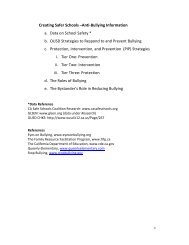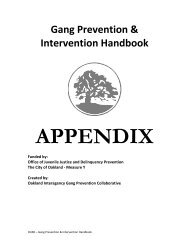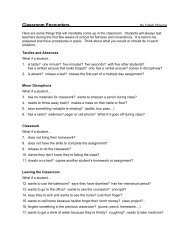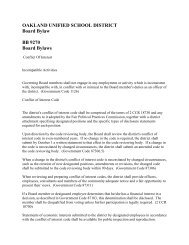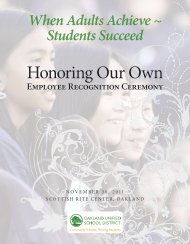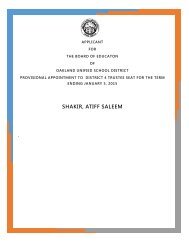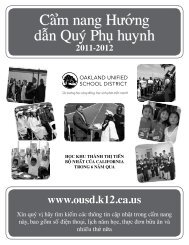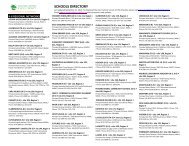Oakland Unified School District Case Study
Oakland Unified School District Case Study
Oakland Unified School District Case Study
You also want an ePaper? Increase the reach of your titles
YUMPU automatically turns print PDFs into web optimized ePapers that Google loves.
Coaches have facilitated many changes<br />
at AWE by increasing individual and<br />
collective capacity, but not all coaching<br />
experiences have been positive. Several<br />
teachers suggested that their Beginning<br />
Teacher Support and Assessment (BTSA)<br />
coaching was too impersonal and focused<br />
on compliance. For example, one teacher<br />
complained that she had to spend all her<br />
preparation periods filling out paperwork<br />
and figuring out what classes counted for<br />
her BTSA program. Others thought their<br />
BTSA coach was stretched too thin, with<br />
too many teachers to support, and that the<br />
BTSA workshops were far removed from<br />
the issues they were working on in their<br />
respective classroom BTSA experiences<br />
were not all negative though, as one teacher<br />
felt she had a positive experience when<br />
she was paired with a coach who was still<br />
working as a teacher.<br />
AWE has been able to effectively build the<br />
capacity of its teachers to make significant<br />
changes in its instructional program<br />
primarily through the use of coaching<br />
and teacher collaboration time. Although<br />
the school has developed a rigorous<br />
selection process that helps move highcapacity<br />
individuals into the school site,<br />
there is a need to cohere these efforts with<br />
district-level human resources policies and<br />
personnel.<br />
Parent & Community Relations<br />
The larger East <strong>Oakland</strong> community has<br />
changed considerably over the past 8<br />
years, and the staff at AWE has worked<br />
hard to build a strong relationship with<br />
the community in a time of shifting<br />
demographics. A community that 8 years<br />
ago was 50% African American and<br />
50% Latino is now approximately 75%<br />
Latino and 20% African American. Many<br />
school leaders acknowledge that these<br />
changes have created a sense of loss for the<br />
community. As one leader put it:<br />
Generations have grown up in this<br />
neighborhood. Now both groups<br />
feel like they’re scrapping over a tiny<br />
piece of the pie. We’ve worked hard<br />
to build bridges with the community.<br />
Eight years ago, African American<br />
parents would say ‘Don’t let my<br />
children play with those Latino<br />
students’ and vice versa. We’ve<br />
worked hard on deconstructing<br />
stereotypes.<br />
AWE has fostered a sense of community<br />
by reaching out to parents, and developed<br />
a common sense of purpose around the<br />
academic mission of the school: preparing<br />
children for college. This sense of common<br />
purpose was evident when a group<br />
of African-American parents contacted a<br />
bilingual teacher at AWE about offering<br />
Spanish classes for parents, so they could<br />
communicate more effectively with parents<br />
who spoke only Spanish.<br />
As one might expect in a school<br />
founded on the grassroots efforts of<br />
community organizers, AWE continues<br />
to be a welcoming place for parents and<br />
community members. <strong>School</strong> leaders work<br />
hard to build connections with families and<br />
continue to utilize community resources<br />
for supporting students in the school. All<br />
parents feel welcome at the school and<br />
convey the importance of that environment.<br />
Parents appreciate the quality of the<br />
instruction the school provides for their<br />
children and comment on the commitment<br />
of the teachers. Parents also appreciate the<br />
personalization strategies built into AWE’s<br />
instructional program. They appreciate<br />
both the individual attention their children<br />
18<br />
<strong>School</strong> Redesign Network at Stanford University



